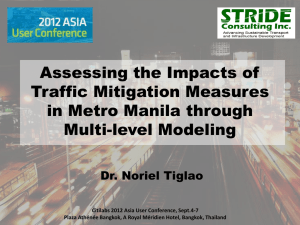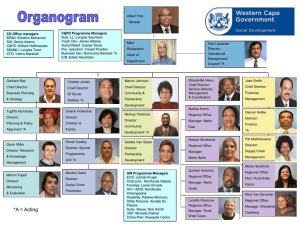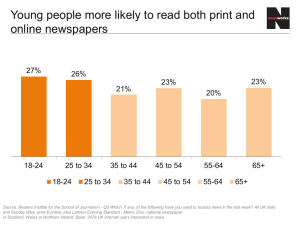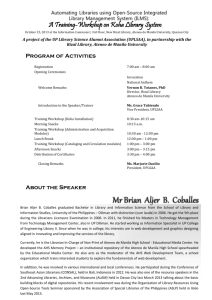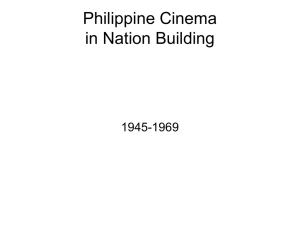Save
advertisement
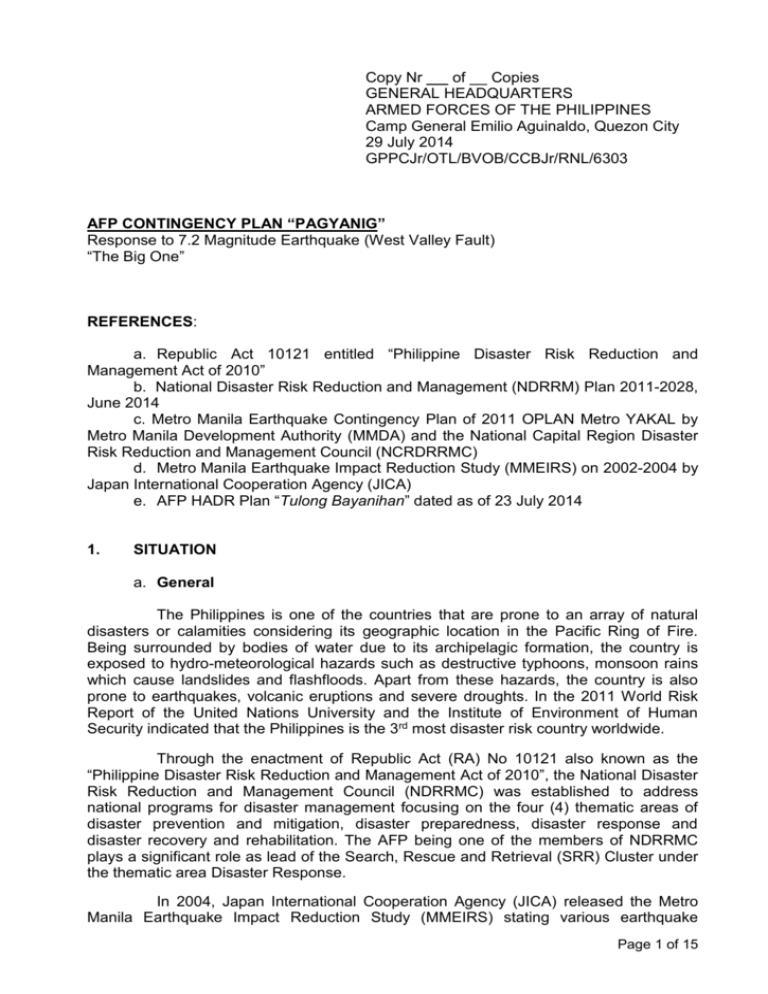
Copy Nr _ _ of __ Copies GENERAL HEADQUARTERS ARMED FORCES OF THE PHILIPPINES Camp General Emilio Aguinaldo, Quezon City 29 July 2014 GPPCJr/OTL/BVOB/CCBJr/RNL/6303 AFP CONTINGENCY PLAN “PAGYANIG” Response to 7.2 Magnitude Earthquake (West Valley Fault) “The Big One” REFERENCES: a. Republic Act 10121 entitled “Philippine Disaster Risk Reduction and Management Act of 2010” b. National Disaster Risk Reduction and Management (NDRRM) Plan 2011-2028, June 2014 c. Metro Manila Earthquake Contingency Plan of 2011 OPLAN Metro YAKAL by Metro Manila Development Authority (MMDA) and the National Capital Region Disaster Risk Reduction and Management Council (NCRDRRMC) d. Metro Manila Earthquake Impact Reduction Study (MMEIRS) on 2002-2004 by Japan International Cooperation Agency (JICA) e. AFP HADR Plan “Tulong Bayanihan” dated as of 23 July 2014 1. SITUATION a. General The Philippines is one of the countries that are prone to an array of natural disasters or calamities considering its geographic location in the Pacific Ring of Fire. Being surrounded by bodies of water due to its archipelagic formation, the country is exposed to hydro-meteorological hazards such as destructive typhoons, monsoon rains which cause landslides and flashfloods. Apart from these hazards, the country is also prone to earthquakes, volcanic eruptions and severe droughts. In the 2011 World Risk Report of the United Nations University and the Institute of Environment of Human Security indicated that the Philippines is the 3rd most disaster risk country worldwide. Through the enactment of Republic Act (RA) No 10121 also known as the “Philippine Disaster Risk Reduction and Management Act of 2010”, the National Disaster Risk Reduction and Management Council (NDRRMC) was established to address national programs for disaster management focusing on the four (4) thematic areas of disaster prevention and mitigation, disaster preparedness, disaster response and disaster recovery and rehabilitation. The AFP being one of the members of NDRRMC plays a significant role as lead of the Search, Rescue and Retrieval (SRR) Cluster under the thematic area Disaster Response. In 2004, Japan International Cooperation Agency (JICA) released the Metro Manila Earthquake Impact Reduction Study (MMEIRS) stating various earthquake Page 1 of 15 scenarios that have potential damage effect in the NCR. Of the different scenario earthquakes studied, the 7.2 magnitude Model 8 West Valley Fault appeared to have the most devastating impact to lives and properties. According to the study, the approximate return period of an earthquake is less than 500 years which is well within the present time since no event occurred along the West Valley Fault after 17 th century. b. Area of Concern Metro Manila, where the seat of government is located shall be protected and secured from threat of all-hazards to ensure stability of the country and continuity of governance and trade. Republic Act No. 10121 provided the organization of the National Capital Region Disaster Risk Reduction and Management Council (NCRDRRMC) to address disaster management in Metro Manila. The AFP’s Joint Task Force – National Capital Region (JTF-NCR) as a member of the regional council supports the NCRDRRMC’s programs and other disaster management activities. c. Risk and Threat It is likely that a failure or collapse in governance will happen in Metro Manila once the 7.2 magnitude earthquake (Model 8 West Valley Fault) occurs. Hence, the threat of total chaos in the metropolis is a great possibility. There will be a breakdown in law and order, total panic and confusion among the affected communities. With this as a grim scenario, there is a need to plan and identify an alternate area where to relocate or transfer the seat of government including the AFP Command and Control. Said area must be a safe and secured location outside Metro Manila. d. Agencies and Friendly Forces The National, Regional and Local DRRMCs, other government and nongovernment organizations and international humanitarian bodies and other organizations will provide humanitarian assistance and conduct disaster response operations at the affected communities in Metro Manila. The AFP through the JTF-NCR, NOLCOM, SOLCOM and other Unified Commands (UCs) with its current capabilities and resources and with the support of SRR cluster members, other concerned agencies, NGOs and international humanitarian organizations will respond to the affected communities. e. Assumptions 1) The AFP GHQ, Major Service Headquarters and JTF-NCR will be affected including its capability to respond and provide Command and Control; 2) Government functions and services will be hampered and a state of emergency will be declared by the President due to massive casualties and destruction in Metro Manila; 3) There will be breakdown in law and order due to chaos and panic. The normal law enforcement operations of the PNP will not be able to stabilize or contain the situation; Page 2 of 15 4) Main road networks to Metro Manila from the north and south will be cut off due to damaged bridges and fallen debris from collapsed structures; 5) There will be political turmoil and security instability as some opposition groups to include threat groups will likely to take advantage of the situation; 6) Massive jailbreaks of political prisoners; former government officials and other high risk detainees; 7) Based on the Metro Manila Earthquake Impact Reduction Study (MMEIRS), the following is the summary of estimated casualties and damages: a) 33,500 dead and 113,600 people injured during the 1st hour; b) 168,300 residential buildings are heavily-collapsed; c) 339,800 residential buildings are partially-damaged; d) Fire outbreaks to around 139,900 buildings; e) Seven (7) major bridges collapsed; f) 4,000 points of water supply pipes broken; g) 30km electric power transmission cables cut; h) 95km aerial and underground PLDT cables cut; and i) 8-10% of public purpose buildings such as hospitals, schools, firefighting facilities, police, LGU and municipal halls are heavily-damaged while 20-25% are partially-damaged. j) Regional separation in the NCR will happen as a result of the 7.2 magnitude earthquake (Model 8 – West Valley Fault) due to broken or damaged road network, fire, building collapse and geographical condition. Metro Manila (MM) will possibly be separated in four (4) regions as follows: i. MM – North composed of Caloocan, Valenzuela, Quezon City, San Juan and Mandaluyong; ii. MM – South composed of Las Pinas, Muntinlupa, part of Paranaque, Makati, Taguig and Pateros; iii. MM – West composed of Navotas, Malabon, Manila, Pasay and part of Paranaque; and iv. MM – East composed of Marikina and Pasig. 2. Mission: The Armed Forces of the Philippines (AFP) leads SRR operations in support of the NDRRMC in order to save lives and mitigate the effects of the 7.2 magnitude earthquake (Model 8 – West Valley Fault) in Metro Manila. Page 3 of 15 3. Execution: a. CSAFP Intent: 1) Purpose: To effectively and efficiently conduct SRR operations and other humanitarian assistance/support activities in NCR. When chaos prevails as a result of the disaster, the AFP will conduct stability and security operations in support to the PNP. 2) End State: Save lives and alleviate human suffering, restore normalcy and maintain law and order; after which, the AFP facilitates the civilian government agencies to immediately resume their normal functions. 3) Lines of Operations/Efforts (LOOs/LOEs): a) Search, rescue and retrieval operations with other SRR cluster members and partner agencies (PNP, BFP, PCG, NBI, PRC, LGU-search and rescue volunteers, and others as identified by the cluster lead); b) Rapid Damage Assessment and Needs Analysis (RDANA) thru aerial survey if possible in coordination with NDRRMC; c) Evacuation of victims and other threatened communities; and d) Security and Stability Operations (SASO) in support to PNP. b. Concept of Operations (CONOPS): Three (3) Phases of Operations The AFP, with its current forces-in-being, capabilities and assets conducts Search, Rescue and Retrieval (SRR) operations and other humanitarian activities to include stability and security operations in Metro Manila in three (3) phases namely Phase I – Pre-Disaster, Phase II – During Disaster and Phase III – Post Disaster. During Phase I, JTF-NCR is takes the lead in the preparation for the mega-disaster in close coordination with NCRDRRMC while NOLCOM, SOLCOM and the other Unified Commands (UCs) are also drawing up their respective contingencies to support the former once the Model 8 earthquake happened in Metro Manila. The Major Services will provide and sustain respective designated HADR units to be placed OPCON to JTF-NCR for the conduct of SRR. Shifting Supported-Supporting Roles Phase II commences once the 7.2 magnitude earthquake (West Valley Fault) hits the NCR. At this point, NOLCOM assumes the lead role of conducting SRR in Metro Manila and becomes the Supported Command since GHQ AFP and JTF-NCR are expected to be incapacitated. SOLCOM and other UCs as Supporting Commands will provide support to NOLCOM not only in SRR but in SASO in support to the PNP. Further, NOLCOM assists GHQ AFP and JTF-NCR to reestablish Command and Control and handover the SRR responsibility in Metro Manila once JTF-NCR has recovered to assume the Supported Command role. In this case, NOLCOM is relegated as Supporting Command. Page 4 of 15 Support to Recovery and Rehabilitation For Phase III, SRR operations is terminated and the AFP units deployed in Metro Manila gradually transform to assisting concerned government agencies to early recovery and rehabilitation. With the enormousness of the damage to infrastructure, AFP resources will be committed heavily on this aspect. Force Provider-Force Employer For this CONPLAN, the Force Provider-Force Employer concept will be followed. As such, the Major Services through their currently deployed and deployable HADR units, shall provide the capabilities (manpower, equipment and training) for SRR operations while the UCs or JTF shall employ them in accordance with the established command and support relationships. Priority of Efforts When the “Big One” happens in Metro Manila, the priority of the SRR mission is life-saving tasks through search and rescue, and prevention of injuries by way of evacuation and transport. Moreover, AFP units will support in the conduct of lifeline restoration such as road debris clearing to facilitate movement of emergency services providers, humanitarian aid/relief, crowd management and law enforcement including security forces for stability operations. Priority of road clearing will be given to those identified as part of the emergency road network namely: EDSA, Roxas Boulevard, Taft Avenue, Osmena Highway and Shaw Boulevard. Others will be identified in detail. Incident Command System For clarity, AFP units deployed for SRR operations in Metro Manila will follow the Incident Command System (ICS) that is being adopted by the NCRDRRMC in carrying out its humanitarian assistance mission. This will allow smooth disaster-related coordination and management among key players and other stakeholders. Further, this will effectively address some persistent issues and problems arising in the past megadisaster experiences the AFP had particularly in dealing with government agencies, local and foreign humanitarian groups and other civilian organizations. c. Tasks: 1) Phase I – Pre-Disaster a) JTF-NCR i. Coordinate with NCRDRRMC-MMDA for the role of the AFP based on its overall plan (OPLAN YAKAL or its subsequent version) for an earthquake scenario (Model 8 7.2 magnitude WVF per MMEIRS). ii. Plan for the relocation of SRR units (OPCON HADR units) including that of SRR cluster members and partner agencies, away from highly vulnerable areas and preposition them in places where they can immediately react without jeopardizing their safety once the earthquake strikes. Page 5 of 15 iii. Coordinate with Task Force “Rainbow” of NCRDRRMC-MMDA for the deployment and conduct of SRR operations using OPCON HADR units according to the regional separation scenario as mentioned in MMEIRS; and iv. Plan for the conduct of other humanitarian assistance missions and operational activities particularly road debris clearing in coordination with NCRDRRMCMMDA Task Force “Rainbow” for interoperability and complementary response operations. b) NOLCOM i. Plan for the availability and security of temporary facilities, probably in Pampanga, to house AFP key facilities and possibly other government agencies to ensure continuity of government functions; ii. Plan for the deployment and conduct of SRR operations based on the regional separation scenario in coordination with JTF-NCR, NCRDRRMC and SOLCOM; iii. Plan for the security of the MSRs between Subic Port/Clarkfield, Pampanga to Metro Manila North Region (based on the perceived Regional Separation scenario – MMEIRS) in coordination with the Regional Public Works and Highways to ensure the safety and security for the entry of responders and other humanitarian aids to NCR; iv. Plan for security and safety of Diosdado Macapagal International Airport and Subic Bay Port as port of entry/disembarkations of the arriving foreign responders and humanitarian aids in coordination with concerned authorities. v. Familiarize with the earthquake contingency plan of NCRDRRMCMMDA (OPLAN YAKAL or its subsequent version) and plan for the corresponding support. c) SOLCOM i. Plan for the security of the MSRs South of Metro Manila in coordination with the Regional Public Works and Highways to ensure the safety and security for the entry of responders and other humanitarian aids to NCR; ii. Plan for the security and safety of Batangas Port as possible port of entry and disembarkation of arriving foreign responders and humanitarian aids in coordination with concerned authorities; iii. Plan for the deployment and conduct of SRR operations based on the regional separations in coordination with JTF-NCR, NOLCOM and NCRDRRMC; iv. Familiarize with the earthquake contingency plan of NCRDRRMCMMDA (OPLAN YAKAL or its subsequent version) and plan for the corresponding support. d) Major Service Commands i. Ensure the highest level of operational readiness of respective designated HADR unit for the conduct of SRR; ii. Provide and sustain SRR units to be placed OPCON to JTF-NCR; Page 6 of 15 iii. Develop contingencies and capacitate engineer units to enhance their mobility capability to open road networks and rapidly repair bridges to ensure unhampered movement of security forces, evacuees and humanitarian aid; iv. Prepare particular open spaces at respective camps/headquarters for possible evacuation sites and consolidation points of responders; v. In coordination with concerned agencies like PHIVOLCS and local city engineer office in Metro Manila, assess and strengthen seismic resistance of buildings and structures inside respective camps and headquarters; and vi. Establish back-up system of utilities particularly power and communication system. e) Other Unified Commands i. Be prepared to conduct SRR operations and other humanitarian support activities in Metro Manila through designated UC HADR JTF together with respective SRR cluster members and partner agencies in support of JTF-NCR, NOLCOM, NCRDRRMC-MMDA and other concerned agencies; ii. Secure MSR and/or sea lanes for the entry/transport of humanitarian aids from respective AORs; iii. Prepare respective airports and seaports as alternate entry/disembarkation point of foreign humanitarian aid and other assistance; and iv. Identify and prepare suitable sites as probable logistics hub for the expected protracted HADR operations in Metro Manila. f) AFPCC i. Plan for the establishment of alternate Command and Control (C2) facility in coordination with NOLCOM, SOLCOM and CENTCOM and if necessary with NCRDRRMC-MMDA; ii. Plan for contingencies to ensure continuity of the AFP Battle Staff functions even after the 7.2 magnitude earthquake strikes Metro Manila; and iii. In coordination with CEISSAFP, prepare mobile C2 facility for probable deployment once current facility is non-operational; g) CEISSAFP i. Coordinate with AFPCC and NOLCOM, SOLCOM and CENTCOM for the establishment of alternate C2 facility as determined. ii. Provide CEIS support for the establishment of alternate C2 facility for the continuity of AFP Battle Staff functions in coordination with NOLCOM, SOLCOM and CENTCOM and NCRDRRMC-MMDA; and Page 7 of 15 iii. Provide mobile C2 facility in coordination with AFPCC for probable deployment once current facility is non-operational. h) GHQ HSC i. In coordination with concerned agencies like PHIVOLCS and local city engineer office, assess and strengthen seismic resistance of buildings and structures inside Camp Aguinaldo, Quezon City; ii. Establish back-up system of utilities particularly power and communication system in coordination with CEISSAFP; iii. Plan for the evacuation of all AFP personnel and dependents living in Camp Aguinaldo; iv. Identify and prepare open spaces in Camp Aguinaldo for possible evacuation sites of nearby affected communities and consolidation points of responders; and v. Perform other tasks as directed i) ISAFP i. In coordination with other intelligence units of the government, BPT provide situation awareness on the impact of the 7.2magnitude earthquake in different parts of Metro Manila as significant input to the interagency RDANA spearheaded by NDRRMC; and ii. Provide sustained running estimates all throughout the operation. iii. Plan for the establishment of alternate communication system to facilitate reporting of information collectors relative to situation awareness on the effect of the disaster. j) CRSAFP i. Plan for the conduct of prompt public affairs activities to develop awareness in time of an earthquake scenario; and ii. Establish prior coordination with JTF-NCR, NOLCOM, SOLCOM and CENTCOM and other task units to effectively provide and synchronize public affairs effort during disaster. k) AFPRESCOM i. Conduct an inventory of Reservists, affiliated groups and other partner organizations capable to conduct SRR operations in Metro Manila; and ii. BPT to augment NOLCOM, SOLCOM and JTF-NCR in the SRR operations and other humanitarian activities in Metro Manila. Page 8 of 15 l) AFPCES i. Ensure immediate operation of commissaries in the earliest possible time once the Big One struck Metro Manila; and ii. Plan to make available necessary foodstuffs and other provisions for AFP personnel and dependents particularly direct victims of the disaster. m) AFPMC i. Organize and plan for the deployment of medical teams in priority areas in coordination with JTF-NCR initially then to NOLCOM once it assumes the lead role in the SRR operations in Metro Manila. ii. Establish lateral coordination with hospitals and other medical facilities in Metro Manila for the evacuation and treatment of victims of the earthquake. n) All AFPWSSUs i. Plan for contingency to shift to HADR missions from current responsibility and functions; and ii. BPT to be deployed in Metro Manila for HADR mission on order, to support NOLCOM initially then JTF-NCR. 2) Phase II – During Disaster a) NOLCOM i. Conduct SRR operations and other humanitarian activities in NCR together with respective SRR cluster members and partner agencies in coordination with JTF-NCR and NCRDRRMC-MMDA; ii. Establish an Operations Center in Metro Manila in coordination with GHQ AFP and JTF-NCR to provide command and control to SRR operations and link this to the Emergency Operations Center of NCRDRRMC-MMDA for collaboration to synchronize all HADR activities involving AFP units and partner agencies; iii. In coordination with NCRDRRMC-MMDA, conduct RDANA with partner agencies to prioritize the conduct of SRR and other humanitarian activities in Metro Manila; iv. Secure the MSRs North of Metro Manila to ensure the safety and security for the entry of responders and other humanitarian aids to NCR; v. Facilitate the relocation of key AFP facilities to include government agencies in pre-designated alternate/temporary facilities in the AO to house AFP key facilities and other government agencies in order to ensure continuity of government functions; vi. Ensure security and safety of Diosdado Macapagal International Airport and Subic Bay Port as port of entry/disembarkations of arriving foreign responders and humanitarian aids in coordination with concerned authorities; Page 9 of 15 vii. Secure MSR between Subic Port/Clarkfield, Pampanga to Metro Manila North Region (based on the perceived Regional Separations – MMEIRS) in coordination with the Regional Public Works and Highways; viii. Evacuate victims to safer areas and identified evacuation sites in Northern Luzon in coordination with the Regional Social Welfare and Development Office; ix. Activate Multi-National Coordinating Center (MNCC) for the coordination on multinational SRR operations and other humanitarian assistance activities in support of the NDRRMC; and x. Be prepared to (BPT) hand-over to JTF-NCR the responsibility as lead in the conduct of SRR operations in Metro Manila as soon as said unit has reestablished Command and Control. NOLCOM will assume the supporting command role. b) JTF-NCR i. Consolidate and reorganize available SRR units from OPCON HADR units, SRR cluster members and partner agencies in Metro Manila in coordination with the NCRDRRMC-MMDA; ii. Conduct SRR operation and other humanitarian activities in NCR together with respective SRR cluster members and partner agencies in coordination with NOLCOM in order to save lives and minimize further losses; iii. BPT assume from NOLCOM the lead role and become the Supported Command in the conduct of SRR operations in NCR as soon as its capability for Command and Control is re-established; c) SOLCOM i. Conduct SRR Operations and other humanitarian activities in NCR together with respective SRR cluster members and partner agencies in support of NOLCOM initially then to JTF-NCR and NCRDRRMC-MMDA; ii. Secure the MSRs South of Metro Manila to ensure the safety and security for the entry of responders and other humanitarian aids to NCR; iii. Ensure security and safety of Batangas Port as possible port of the entry and disembarkation of the arriving foreign responders and humanitarian aids in coordination with concerned authorities; and iv. Evacuate victims to safer areas/identified evacuation sites in Southern Luzon in coordination with the Regional Social Welfare and Development Office. d) Other Unified Commands i. Deploy in Metro Manila the organized UC HADR JTF together with respective SRR cluster members and partner agencies to be placed OPCON initially to Page 10 of 15 NOLCOM then will shift to JTF-NCR upon its assumption of the lead role in SRR operations in the metropolis. ii. Secure respective MSR and/or sea lanes for the entry/transport of humanitarian aids from respective AORs; iii. Secure respective airports and seaports once designated as alternate entry/disembarkation point of foreign humanitarian aid and other assistance; and iv. Secure designated HADR logistics hub for the storage of humanitarian aid and relief as necessary. 3) Phase III – Post Disaster a) JTF-NCR i. Terminate SRR operations and shift to recovery and rehabilitation efforts in affected areas in coordination with NCRDRRMC-MMDA Task Force Rainbow; ii. BPT receive OPCON of all AFP units that will be deployed in Metro Manila to augment in the expected massive recovery and rehabilitation mission; iii. Assume the administration and operation of the Multi-National Coordinating Center (MNCC) from NOLCOM in coordination with GHQ AFP and NDRRMC-OCD; iv. Support in the conduct of lifeline restoration such as road debris clearing operation to facilitate movement of emergency services providers, humanitarian aid/relief, crowd management and law enforcement including security forces for stability operations. b) NOLCOM and SOLCOM i. Support JTF-NCR and other concerned agencies in the conduct of lifeline restoration particularly road debris clearing from the north and south portions of Metro Manila moving towards the metropolis; ii. Facilitate the unhampered movement of humanitarian aid from the north and south of Metro Manila; and iii. Continue to provide support to JTF-NCR in the recovery and rehabilitation efforts in Metro Manila. c) Other Unified Commands i. Maximize deployment of available OPCON forces to Metro Manila to support JTF-NCR in its recovery and rehabilitation efforts; and ii. Continue to secure respective MSR and/or sea lanes including RORO ports for the entry/transport of humanitarian aids from respective AORs. d) Major Service Commands Page 11 of 15 i. Sustain respective HADR units placed OPCON to JTF-NCR and now involved in the recovery and rehabilitation works; ii. Secure respective headquarters/camps particularly once open spaces are used as evacuation sites and consolidation points of responders; and iii. Direct respective Reserve Commands for the utilization of reservists in the recovery and rehabilitation efforts in Metro Manila. d. Coordinating Instructions: 1) Once the “Big One”, Model 08 West Valley Fault strikes Metro Manila, NOLCOM becomes the Supported Command while the other Unified Commands are the Supporting Commands. This becomes automatic to have seamless response and Command and Control particularly in the conduct of SRR operations. 2) Major Services to ensure the highest level of operational readiness of respective HADR units and sustain operational requirements of deployed/OPCON units to JTF-NCR. 3) Deployment of the interagency Rapid Damage Assessment and Needs Analysis (RDANA) Teams will be under the authority of NDRRMC. However, the AFP may immediately conduct RDANA in support of the NDRRMC through aerial survey if possible. 4) Priority of effort aside from SRR operations is the conduct of immediate debris clearing operations along major thoroughfares in NCR. 5) All Major Service Commands to provide manpower and transportation support for force evacuations when necessary or once the situation warrants. 6) All task units to provide emergency communications particularly to NCRDRRMC-MMDA and partner agencies. 7) All task units to provide security support in evacuation centers; hospitals; damaged infrastructures and establishments in coordination with the PNP. 8) All relief operations must be coordinated with the Regional Social Welfare and Development office. 9) In coordination with the PNP, provide security support for continuity of government functions/operations. 10) All task units to conduct other engineering operations in coordination with Regional Public Works and Highways Office. 11) Once the “Big One” occurs, immediately secure predetermined main and alternate ports of embarkation and disembarkations; 12) All task units to provide support to the PNP in its law enforcement operations. Page 12 of 15 13) In coordination with the PNP, all task units to provide force protection to foreign responders if any. 14) Priority of evacuation is based on the succession of command in the National Government and the AFP leadership. 15) All AFP units particularly those who will be affected by the 7.2 magnitude earthquake in Metro Manila shall develop a system for accounting of personnel. Initially, all affected AFP personnel will report to the nearest military unit for accounting purpose. 16) The following are the identified open spaces (among other possible areas) that shall serve as primary evacuation sites/camps for mass evacuations: i. Veterans Golf Course in North Avenue, Quezon City for the North Metro Manila Sector - 56 hectares area; ii. Camp Jesus Villamor Air Base Golf Course in Pasay City for the South Metro Manila Sector - 60 hectares area; iii. Wack Wack Golf Course in Mandaluyong City for the Eastern Metro Manila Sector – 101 hectares area; and iv. Intramuros Golf Course in Manila for the West Metro Manila Sector – 23 hectares area. 18) All task units to conduct regular situational awareness to prioritize the conduct of disaster response. 19) For the Primary and Alternate Ports, the three (3) NAIA terminals and Port Area Manila and/or PN Hqs, Roxas Boulevard, Pasay City will be the primary airport and seaports of disembarkations of arriving foreign responders and humanitarian aids in case said facilities are not damaged. Alternate is CAB, Pampanga and Subic Bay Port, Zambales. 20) All Unified Commands/JTF-NCR and the Major Services will submit their implementing and support plans, respectively ten days after the publication of this CONPLAN. 21) This CONPLAN is a living document. Revisions will be made once there are new developments particularly on the MMEIRS and the AFP organization. IV. Administrative and Logistics Support: a. Concept of Support. The Force Provider - Force Employer concept will be followed in sustaining the operational requirements of deployed HADR units. Under this concept, the Major Services, Force Provider shall provide the logistical requirements of respective component units placed OPCON to JTF-NCR and other Unified Commands as the Force Employer. Personnel requirement will be provided and rotation will be undertaken by the Major Services in coordination with the Unified Commands. Page 13 of 15 b. Other logistics support will be programmed and provided by OJ4, AFP in coordination with the concerned Unified Commands to further sustain the operational requirements of HADR units in the conduct of SRR operations and other humanitarian activities. V. Command and Control a. Succession of Command: 1. National Government: The hierarchy in the National Leadership of the country is from the President, Vice-President, Senate President and the Speaker of the House, in that order based on the 1987 Philippine Constitution. Precedence of the members of the Cabinet is hereto attached. 2. AFP Leadership: For the purpose of this CONPLAN, the succession of command in the AFP will be from the Chief of Staff, AFP; Vice Chief of Staff, AFP; The Deputy Chief of Staff, AFP; Major Service Commanders (PA, PAF, PN in that order); Commanders, NOLCOM, SOLCOM, and CENTCOM in that order. b. Communication “GERONIMO” in effect. Electronics and Information System: Current CEOI Acknowledge. CATAPANG JR General Page 14 of 15 Attachment to AFP CONPLAN PAGYANIG dated 29 July 2014 - Precedence of Cabinet Members The following is the precedence of the Cabinet Members: Secretary of Foreign Affairs Executive Secretary Presidential Spokesperson Secretary of Finance Secretary of Justice Secretary of Interior and Local Government Secretary of Health Secretary of Agriculture Secretary of Public Works and Highway Secretary of Transportation and Communication Secretary of Education Secretary of Social Welfare and Development Secretary of Labor and Employment Secretary of Budget and Management Secretary of National Defense Secretary of Science and Technology Secretary of Agrarian Reform Secretary of Tourism Secretary of Trade and Industry Secretary of Environment and National Resources Secretary of Energy Chairperson, Commission on Higher Education Other Official with Cabinet Rank Director General of the National Economic and Development Authority Presidential Communication Development and Strategic Planning Officer Press Secretary (Presidential Communication Operation Office) Director General, National Secretary Council Head of the Presidential Management Staff Solicitor General Chief of the Presidential Legal Counsel Chairman of the Metropolitan Manila Development Authority Secretary of the National Commission on Muslim Filipinos Secretary of Mindanao Development Authority Secretary, Office of the Lead Convener of the NAPC Presidential Adviser on the Peace Process Presidential Legislative Liaison Officer Presidential Adviser on Political Affairs Source: Official Gazette of the Republic of the Philippines Page 15 of 15

